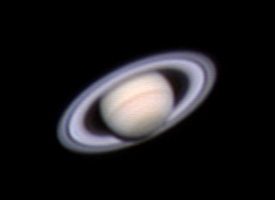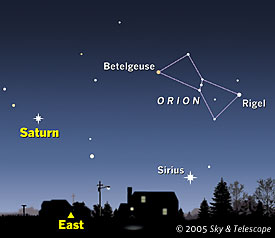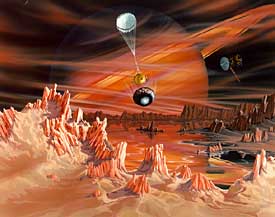
Saturn as imaged by a webcam on a 5-inch telescope in excellent seeing. Sky & Telescope's Sean Walker used a ToUCam Pro video camera on a 5-inch f/6 Maksutov-Newtonian telescope with a 5x Barlow lens on the evening of March 30, 2004. He stacked 443 frames with RegiStax software to create this view.
Sky & Telescope photo by Sean Walker.
Taking a peek at Saturn through a telescope is fascinating any time, but the view will take on extra significance tonight and tomorrow morning. That's because a European-built probe called Huygens will plunge into the dense atmosphere of Titan, Saturn's largest moon, relaying pictures and other data as it parachutes to the surface. Touchdown (or perhaps splashdown!) is scheduled to occur around 7:30 a.m. Eastern Standard Time on the morning of January 14th.
Huygens hitched a ride to Saturn on NASA's Cassini spacecraft, which has been orbiting the ringed planet since July 2004. Anyone with a telescope can share in the excitement of Huygens's history-making descent by tracking down Saturn and Titan in the evening sky. By coincidence, Saturn is at its closest to both the Sun and the Earth right now. And Saturn's rings are tipped toward us by 23°, nearly the maximum possible angle.

The ringed planet Saturn is easy to find on January evenings in 2005. Just look east (opposite where sunset occurred), locate the constellation Orion, then look for the brightest "star" to its left. It's not a star at all — it's Saturn!
Sky & Telescope illustration by Steven A. Simpson.
These favorable circumstances make the ringed planet especially bright and easy to find. Look southeast in early evening for the distinctive rectangular shape of the constellation Orion. Saturn is the brightest "star" in the region of sky off to Orion's left in the east. It's about the width of two wide-open hands (seen at arm's length) from the vertical row of three stars in Orion's Belt.
Even though Saturn is currently 750 million miles (1.2 billion kilometers) from Earth, its round disk and rings will be apparent when seen through even the smallest telescope. Saturn is tipped so that we are viewing its southern hemisphere, and a telescope with a diameter of at least 4 inches should reveal a black, razor-thin band (the Cassini Division) splitting the rings in two. You'll see more detail if you wait until late evening, when the planet is higher up in the sky.

Delivered by NASA's Cassini orbiter, the European Space Agency's Huygens probe descends toward the cloud-shrouded surface of Titan. Saturn's largest moon has a thick atmosphere of nitrogen and methane and may have lakes of liquid hydrocarbons.
Artwork by Craig Attebery; courtesy NASA/JPL/Caltech.
Titan, with a diameter of 3,200 miles (5,150 km), is larger than either Mercury or Pluto. It circles Saturn every 16 days, traveling in an orbit about 760,000 miles (1.2 million km) from the planet. Titan looks like a a faint but distinct "star" hovering near Saturn. You can determine its location on any date, at any time, using our handy JavaScript utility.
For a detailed timeline of the Huygens descent to Titan, see the European Space Agency's Cassini-Huygens Web site.
 0
0
Comments
You must be logged in to post a comment.